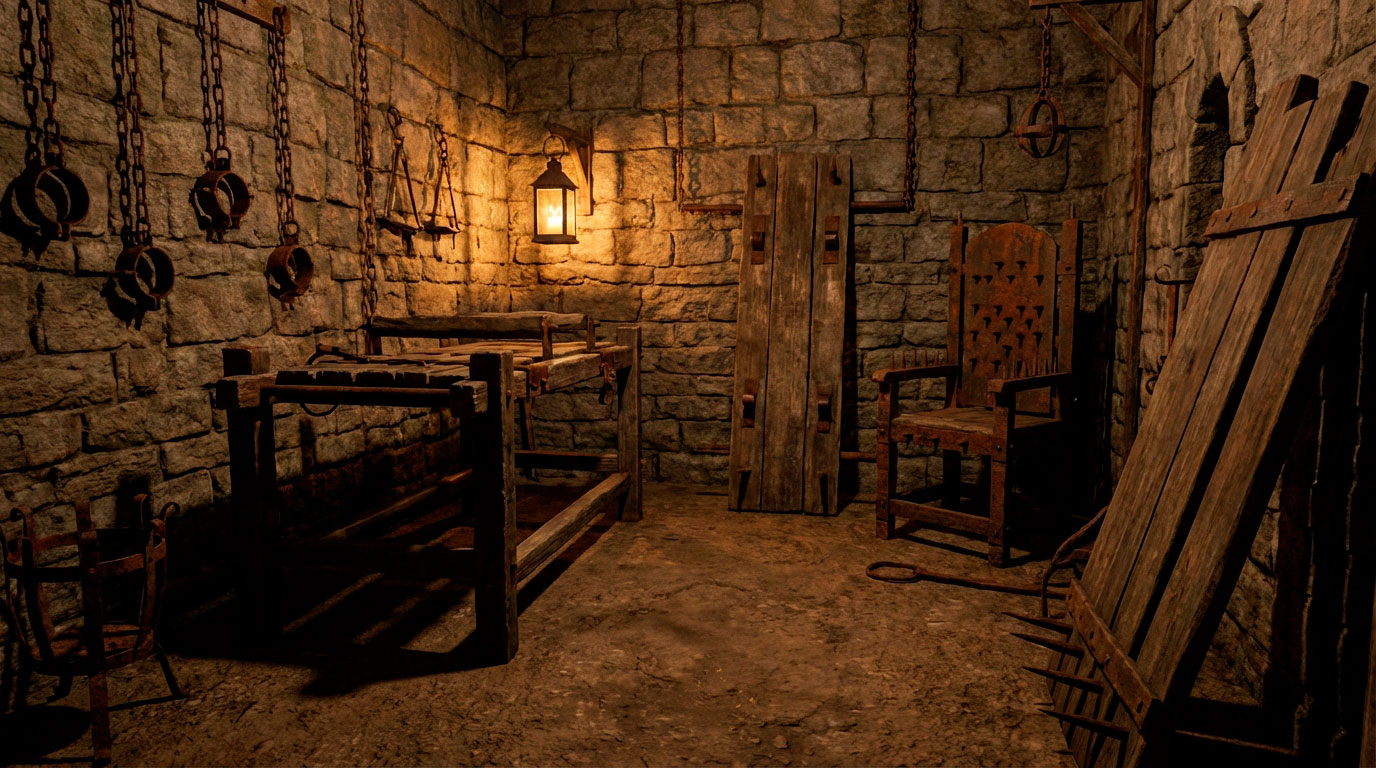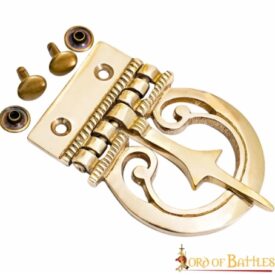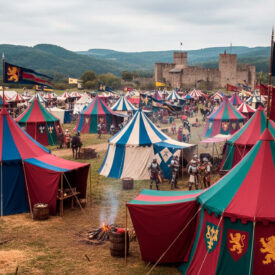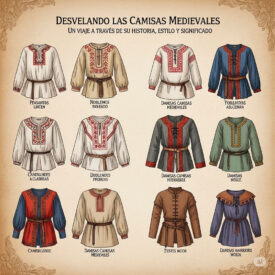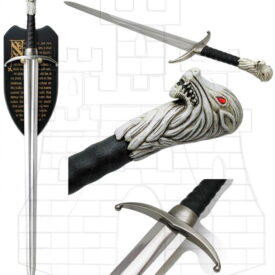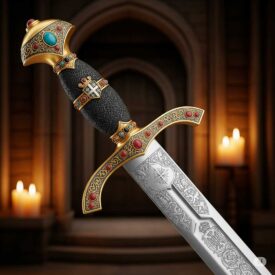Do you dare to explore the darkest corners of history, where suffering became the art of cruelty? The Middle Ages, with its mysticism and epic battles, also harbored a gloomy side: that of torture instruments. These tools, designed to break body and spirit, reveal a chilling facet of justice and power of old. Join us on a journey through time to uncover the most sadistic and lethal devices that marked an era.
Torture: A pillar of medieval justice
Far from being impulsive acts of barbarism, torture in the Middle Ages was an integral component of judicial proceedings. It was conceived as a tool to “obtain the truth,” a means to extract confession, considered the “queen of proofs.” From basic corporal punishments like flogging to more complex devices, every torment sought to break the accused’s will. Although courts demanded that death or permanent damage not be caused (with the presence of a doctor being a formal requirement), reality often blurred those lines.
Confessions obtained under duress had to be ratified afterward; if the prisoner recanted, the torment could be repeated, transforming the initial confession into new evidence of guilt. A vicious circle of agony and despair.
Torture instruments: historical lineage and key moments
The evolution and use of torture instruments span from Antiquity to the Modern Age; many ancient artifacts were reintroduced in the Middle Ages, judicial torture was institutionalized in the Late Middle Ages (c. 13th–15th centuries), and the 15th–17th centuries saw an upsurge in penal torments and especially sadistic methods. Below is a chronology ordered by eras and relevant events.
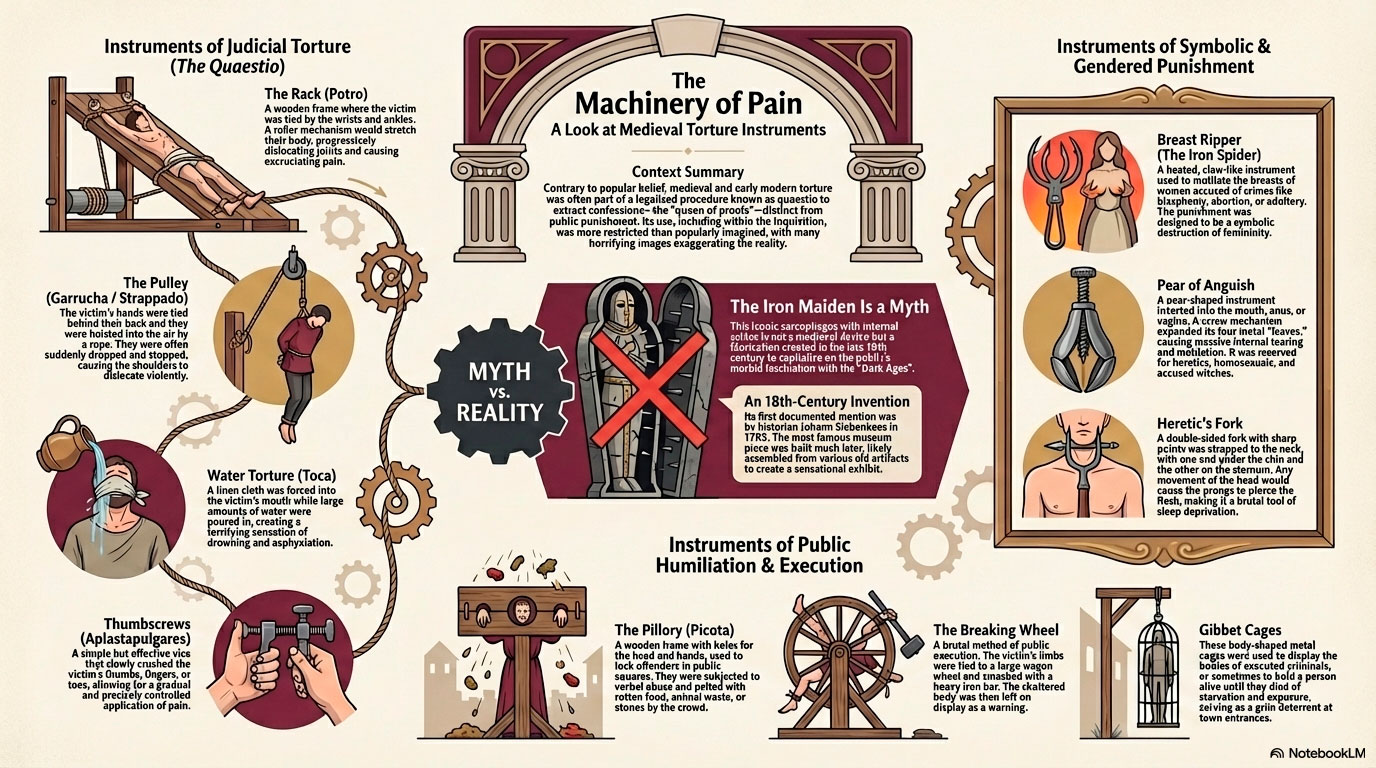
| Era | Event |
|---|---|
| Antiquity (until the 5th century AD) and medieval reintroduction | |
| Brazen Bull of Phalaris (6th century BC) | Hollow bronze device used in Greek Sicily: the victim was enclosed and burned alive. A paradigmatic example of an ancient penal ordeal; symbolizes extreme cruelty. |
| Thumbscrew (ancient) | Simple mechanism—a screw that crushes thumbs or fingers—of remote use and re-employment in later eras as an instrument of pain, mutilation, and coercion. |
| Late Middle Ages (c. 13th–15th centuries) — institutionalized judicial torture | |
| Institutionalization of torture (c. 13th–15th centuries) | Torture was systematized in European courts for the procedural purpose of obtaining confession (confessio, “queen probationum”). Specific procedures and devices were normalized. |
| The Rack / Ecúleo (introduced in the Tower of London ca. 1420) | Frame with rollers and ropes to stretch the prisoner, capable of dislocating or dismembering joints. Used as a judicial instrument; variants were employed in the Inquisition from the 16th century. |
| Strappado (medieval era) | Tying by the wrists and lifting with a pulley (sometimes with weights on the feet); holding for a time or abruptly releasing could cause dismemberment of the arms. A typical method of judicial torment. |
| Borceguí (c. 15th century) | Wooden planks and straps that compressed the ankle until bones fractured; a technique of mutilation and intense pain documented around the 15th century. |
| Late Middle Ages – 17th century — penal torments and public mutilations | |
| Breaking wheel (Late Middle Ages–early 18th century) | Public ordeal where the victim was tied to a wheel and/or their bones were crushed by the wheel; used as execution and prolonged punishment until the early 18th century. |
| Stake and pyre (until the 17th century) | Execution of heretics and supposedly witches by public burning; practice present in several countries until the 17th century (e.g., France, England). |
| Judas Cradle | Lifting and lowering the prisoner onto a conical point so that the weight rested on the anus, vagina, scrotum, or coccyx; the executioner varied the pressure to inflict prolonged and degrading pain. |
| Gender mutilation instruments | Devices often directed against women accused of witchcraft, abortion, blasphemy, or “undesired” conduct: includes the Breast Ripper (pincers/points, sometimes applied red-hot) and the Pear of Anguish (internal introduction and expansion to tear). |
| Head Crusher / Skull Breaker | Upper cap pressed by a screw that destroys teeth and jaw and ends in massive cranial injuries; an instrument designed to break and kill atrociously. |
| Early Modern and later periods (15th–18th centuries) — proliferation, penal uses, and mythifications | |
| “Golden Age” of tortures (15th–16th centuries) | Period of maximum creation and variety of torture methods (judicial and penal), partly linked to inquisitions, wars, and severe penal legislation in Europe. |
| Scavenger’s Daughter (16th century; reign of Elizabeth I) | Metal structure for breaking bones by pressure documented in the 16th century, associated mainly with England and the period of Elizabeth I. |
| Iron Maiden (second half of the 18th century) | Artifact popularized in the 18th century as a sensationalist piece: sarcophagus with internal spikes whose fame is later and largely a product of mythification and anticlerical/outdated propaganda; it is not an authentic medieval instrument. |
The devices of torment: history’s most sadistic instruments
In its darkest side, the human mind has devised tools of unimaginable suffering. Below, we explore some of the most sadistic and lethal instruments, used both to obtain confessions and to punish exemplarily.
The Rack: The agony of stretching
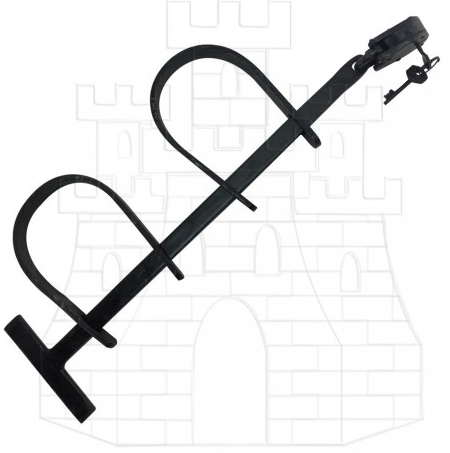
Considered one of the most brutal methods, the rack was the king of torment. The victim was tied hand and foot to a wooden frame or bed with a winch. When turned, this winch stretched the limbs in opposite directions, dislocating joints and, in extreme cases, dismembering the body. The pain was unbearable, potentially causing death by cessation of vital functions.

This instrument was one of the three methods most used by the Spanish Inquisition, along with the strappado and water torture. Its design allowed for modulating the level of pain, always seeking confession before the prisoner’s death. The rack represented malevolence at its fullest expression, transforming the human body into a spectacle of cruelty.
The Judas Cradle: The pyramidal ordeal
pyramid with a wooden point, often uncleaned to increase the risk of infection, served as a bed of torment. The victim was suspended by the waist and slowly lowered, or shaken, onto the vertex, so that the weight of their body rested on extremely sensitive areas such as the anus, vagina, or scrotum. This method inflicted excruciating pain, aiming more for humiliation and prolonged suffering than a quick death.
The Iron Maiden: A myth of terror, yet a symbol of cruelty
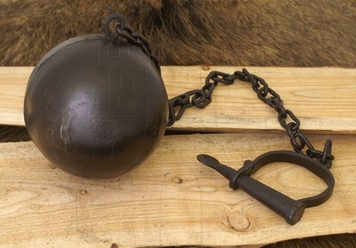 Although modern historiography considers it a later invention (late 18th century) to discredit the Inquisition, the image of the Iron Maiden has endured as an icon of medieval cruelty. This human-shaped sarcophagus, lined with internal spikes, supposedly trapped the victim, driving the spikes in to avoid vital organs and prolong a slow agony by bleeding. A terrifying reminder of how fiction can embody the greatest fears of an era.
Although modern historiography considers it a later invention (late 18th century) to discredit the Inquisition, the image of the Iron Maiden has endured as an icon of medieval cruelty. This human-shaped sarcophagus, lined with internal spikes, supposedly trapped the victim, driving the spikes in to avoid vital organs and prolong a slow agony by bleeding. A terrifying reminder of how fiction can embody the greatest fears of an era.
The Pear of Anguish: Tearing from within
This mechanical device, with four metal leaves that expanded when a crank was turned, was inserted into bodily orifices such as the mouth, anus, or vagina. Its expansion tore tissues from within, causing unimaginable pain. It was employed against heretics (oral), homosexuals (rectal), and women accused of witchcraft or fornication (vaginal), being a gendered punishment that sought mutilation and extreme suffering.
The Breast Ripper: Female mutilation
Also known as the Iron Spider, this four-pronged artifact, often heated red-hot, was used to rip women’s breasts, leaving them as “shapeless masses.” A specific punishment for women accused of witchcraft, blasphemy, adultery, or abortion. Mutilation was an exemplary act, designed to defame and deter others.
The Breaking Wheel: The most Dantean public punishment
This method of execution and torment, common in Germanic Europe, consisted of tying the naked victim face up to a huge wheel, while the executioner crushed their bones and joints with violent blows, even dismembering them. In other variants, a bonfire was lit under the wheel, “cooking” the victim slowly. A Dantean spectacle that served as a public warning and a symbol of judicial power.
Hanging Cages: Dying in plain sight
Cages of scorn were placed in prominent locations, such as buildings or town entrances. The condemned, often already tortured, were locked up naked or semi-naked and exposed to the elements, dying of hunger and thirst. The bodies remained hanging until only bones remained, offering a macabre social deterrent.
Prisons and ordeal: Beyond the tools
In addition to torture instruments, simple confinement and immobilization were methods of suffering. Medieval dungeons, cold and dark, were precursors of agony. Immobilizing body limbs with shackles or collars was a form of constant torment, limiting mobility and plunging the prisoner into a state of helplessness.
Likewise, chastity belts, although their widespread use is controversial and often considered a myth due to the serious risks of infection, were associated with the idea of ensuring fidelity or protecting women from violence in times of war. A macabre reflection of the mindset of control over the female body in past eras.

Clearing up unknowns about historical torture instruments and effects
What was the main purpose of the “Judas Cradle”?
The main purpose of the “Judas Cradle” was to obtain quick confessions through torture, inflicting extreme pain on the prisoner by suspending them or letting them fall onto a pointed pyramid that penetrated sensitive areas such as the genitals or anus. Additionally, it served to punish and humiliate the prisoner and to deter others from challenging authority through public terror.
How exactly did the “rack” work?
The rack was a structure designed to safely immobilize animals during veterinary procedures and shoeing. Its operation was based on an ingenious mechanical system that combined elements of wood and stone.
Support posts: Four or six granite monoliths extracted from local quarries, firmly anchored to the ground, which formed the structural base.
Yoke or lubio: A horizontal piece of wood that held the animal’s head, ensuring its fixed position.
Strap holders: Two parallel wooden crossbars that could rotate on an axis, allowing the animal to be lifted off the ground using leather or rope straps.
Handrests and knee pads: Small vertical blocks with hooks adjusted in height to immobilize the limbs without damaging them.
The procedure followed an ordered sequence:
- Animal entry: The animal entered the rack on the side opposite the head and was tied to a chain to prevent it from escaping.
- Head fixation: The animal’s head was positioned in the yoke and secured with a side bar.
- Body elevation: Two leather straps were passed under the animal’s belly. When the strap holder crossbars were turned, these straps tightened, lifting the animal off the ground until the mechanism hit a bar that limited movement.
- Limb immobilization: Knee pads were used to block one or more legs, securing the hoof without causing damage, thus allowing the shoeing work to be done.
This system allowed the farrier to perform his work safely, preventing kicks, blows, or horn thrusts while the animal remained still but without suffering injuries.
What other torture methods were common during the Inquisition?
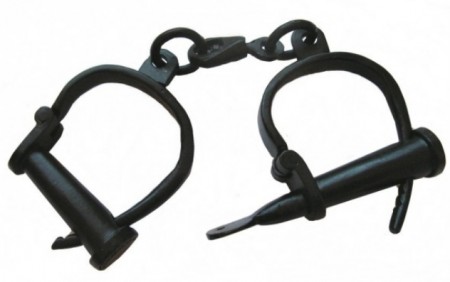 During the Inquisition, in addition to the best-known methods, other torture procedures were common, such as the strappado (suspending the prisoner by the wrists and letting them fall abruptly), the rack (stretching the accused’s limbs until dislocated or dismembered), water torture (causing a sensation of drowning by introducing water through the mouth or nose), the Judas Cradle (placing the prisoner on a wooden pyramid), the iron maiden (locking the victim in a sarcophagus with internal spikes), the breaking wheel (hitting and crushing the body on a wheel), the barrel pillory (humiliating the prisoner by forcing them to carry a barrel full of excrement), the gag, the oral, rectal, or vaginal pear (introducing an object that expanded inside the body), the head crusher, the garrote vil, the inquisitor’s chair, the breast-ripper machine, the skull breaker, the thumbscrews, and the knee-breaking machine.
During the Inquisition, in addition to the best-known methods, other torture procedures were common, such as the strappado (suspending the prisoner by the wrists and letting them fall abruptly), the rack (stretching the accused’s limbs until dislocated or dismembered), water torture (causing a sensation of drowning by introducing water through the mouth or nose), the Judas Cradle (placing the prisoner on a wooden pyramid), the iron maiden (locking the victim in a sarcophagus with internal spikes), the breaking wheel (hitting and crushing the body on a wheel), the barrel pillory (humiliating the prisoner by forcing them to carry a barrel full of excrement), the gag, the oral, rectal, or vaginal pear (introducing an object that expanded inside the body), the head crusher, the garrote vil, the inquisitor’s chair, the breast-ripper machine, the skull breaker, the thumbscrews, and the knee-breaking machine.
What differences existed between torture instruments used in different European countries?
The differences between torture instruments used in different European countries can be distinguished mainly by their origin, design, and the cultural/legal context in which they were employed:
- Spain: The Spanish Inquisition was notable for using instruments such as the Judas cradle (a pyramidal device for psychological and physical torture), the rack (a board with a winch to stretch and dislocate limbs), and the thumbscrew (of Venetian origin, for crushing fingers). In Spain, torture was commonly a formal part of the inquisitorial and judicial process.
- Germany: Primarily associated with the iron maiden, a coffin with internal spikes that caused multiple wounds without instant death, seeking to prolong suffering. This instrument is emblematic in Germany and less common in other countries.
- Germanic Europe (including regions like Flanders and Germany): Prolonged use of the breaking wheel or Catherine wheel, where the victim was tied to a wheel and then beaten to dismember them; it was both torture and an execution method that conveyed a terrifying public message. This practice was common from Antiquity to the 19th century.
- Russia and other Eastern European countries: Introduced instruments such as the butterfly screw for compressing fingers with screws, originating in the Russian army and then extended throughout Europe for minor punishments or to force confessions.
- Ancient Rome and Greece: Used different methods such as the Roman rack to stretch the condemned, hot metal torture, flogging, and other devices such as hooks to tear flesh. These methods influenced the evolution of torture in medieval Europe.
The variation in European torture instruments was related to legal traditions, the influence of the Church or the State, and their specific purposes (punishment, execution, confession). Spain stood out for complex and symbolic elements in the Inquisition, Germany for the prolonged suffering with the iron maiden, Germanic Europe for the visible brutality of the wheel, and Russia for mechanical devices for specific punishments.
What psychological impact did these torture methods have on victims?
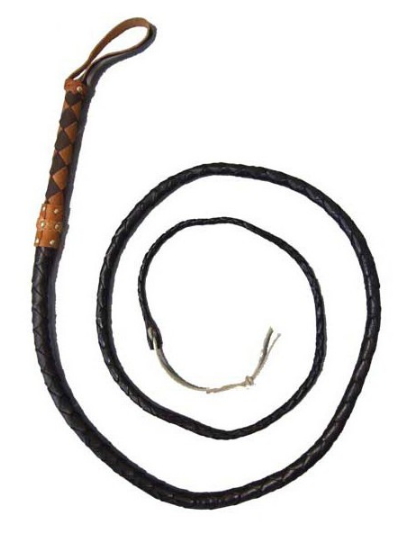 Torture methods generated deep and lasting psychological damage in victims, often more persistent than any physical injury. Torture was specifically designed to attack the fundamental modes of individual psychological and social functioning, destroying their internal mental life and social relationships.
Torture methods generated deep and lasting psychological damage in victims, often more persistent than any physical injury. Torture was specifically designed to attack the fundamental modes of individual psychological and social functioning, destroying their internal mental life and social relationships.
The most common symptoms experienced by victims included anxiety, depression, insomnia, nightmares, and emotional instability. Many people suffered memory loss, difficulty concentrating, and intense fear. In more severe cases, victims exhibited suicidal ideation, hallucinations, and panic attacks.
The impact was particularly persistent in the long term. In a study on torture victims during the Chilean military dictatorship, forty years after the events, 54.5% still presented symptoms of anxiety, 45.5% symptoms of depression, and 16.7% post-traumatic stress disorder. Additionally, 66.6% of participants maintained recurrent thoughts and memories about the events.
Psychological torture employed sophisticated methods designed to inflict mental suffering without necessarily harming the body. These included:
- Cellular isolation and confinement in extremely small spaces
- Prolonged sleep and sensory deprivation
- Threats and humiliation, including forced nudity and exposure to extreme temperatures
- Forcing to witness the torture of family members
- Restriction of personal hygiene and access to basic services
Torture caused traumatic effects that in extreme cases led to the disintegration of personality, with serious complications such as addictions and suicide. Victims experienced an extreme reduction to a position of helplessness, where their sense of security, survival, identity, and self-esteem were profoundly compromised.
The consequences included changes in vital interests, emotional alterations, and reactions characteristic of post-traumatic stress. Many victims also suffered chronic pain in muscles and joints, generally located in the places where torture was applied, evidencing the connection between physical and psychological harm.
Torture, although abolished in most modern judicial systems, reminds us of one of the darkest periods in human history. The study of these instruments allows us to reflect on humanity’s capacity for cruelty, but also on the constant struggle for dignity and human rights. Although the past is immutable, its study teaches us valuable lessons to build a future where barbarity is merely an echo of remote times.
